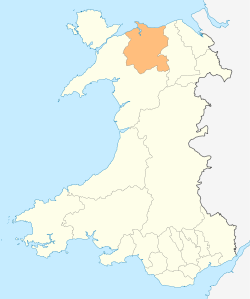Mochdre, Conwy
| Mochdre | |
 The View (Welsh: Yr Olygfan) |
|
 Mochdre |
|
| Population | 1,923 (2011) |
|---|---|
| OS grid reference | SH826786 |
| Community | Mochdre |
| Principal area | Conwy |
| Ceremonial county | Clwyd |
| Country | Wales |
| Sovereign state | United Kingdom |
| Post town | COLWYN BAY |
| Postcode district | LL28 |
| Dialling code | 01492 |
| Police | North Wales |
| Fire | North Wales |
| Ambulance | Welsh |
| EU Parliament | Wales |
| UK Parliament | Clwyd West |
| Welsh Assembly | Clwyd West |
Coordinates: 53°17′N 3°46′W / 53.29°N 3.76°W
Mochdre is a village and an electoral ward to the west of Colwyn Bay in Conwy County Borough, Wales. Originally part of the municipal borough of Colwyn Bay prior to local government reorganisation in April 1974, it is now a separate community whose population at the 2001 census was 1,862,[1] increasing to 1,923 at the 2011 census.[2]
Origin of the name
The name of the village comes from Welsh language words meaning pig (moch) and town (tref). The origin of the name is explained in one of the mythological Welsh tales known as the Four Branches of the Mabinogi, which were first written down in the early Middle Ages, but which actually go much further back into the history of oral Welsh storytelling. An incident in one of these tales, Math fab Mathonwy, concerns the theft of a herd of sacred pigs. One of the places where the stolen animals were kept overnight became known as Mochdre ("Pigtown") as a result.[3]
History and amenities
The village of Mochdre is noted for its parish church, which is actually the church of the parish of Llangwstennin as it allegedly sits on the site of the oldest Early Christian church in Wales.
Mochdre has a place in railway history. Sited on the North Wales Coast Line from Chester to Holyhead, it was the location of experimental trackside water troughs, from which passing steam locomotives could scoop up fresh water supplies without having to stop.The troughs were supplied with water from two square ponds to the south of the Railtrack and in the fields of the old Eagles farm. This was farmed by Mary Douglas (née Morris), who had three daughters Rhoda Grace, Annie and Henrietta. Mary Douglas's husband was Archibald Douglas of Terdan Hall, who died in the late 1920s he had been invalided out of the Grenadier Guards. Mary Douglas's brother farmed Peulws farm old Colwyn. The first infant School in Mochdre was held in the Methodist chapel schoolroom in Chapel Street. The station master's house was on the Llangwstennin side of the railway line. It was a two-storey redbrick building and the stationmaster in the 20s and early 30s was a Mr Stretton who had I believe three daughters and who, when the railway station closed went to live in Tan-yr-allt Avenue, Mochdre. Above Llangwstennin Rectory was a shale quarry. The shale was crushed at the quarry and conveyed by a covered belt conveyor down to a rear residing just north of the main railway line where it was so store in silos to be taken to somewhere in England to extract I believe paraffin wax. When the only road through Mochdre was along the old highway, Thornton steam lorries carrying ruby bricks used to stop on the bridge over the river and replenish their water tanks. These devices became commonplace around the world, but Mochdre was the first place they were ever used, around October 1860. Ironically the exact spot is now a stretch of the A55 dual carriageway, the railway line having been realigned slightly to the west when this section of the road was built in the mid-1980s. Here too was Mochdre & Pabo railway station, closed originally in January 1917 as a World War I economy measure, reopened in May 1919, and finally closed for good in January 1931. The area has been established an industrial area with much industrial and wholesale retail activity, notably Quinton Hazell, a large automotive accessories manufacturer being their base in the village. Latterly this complex is home to the Quinton Hazell Enterprise Park, incorporating mixed office and industrial accommodation.
References
External links
| Wikimedia Commons has media related to Mochdre. |
